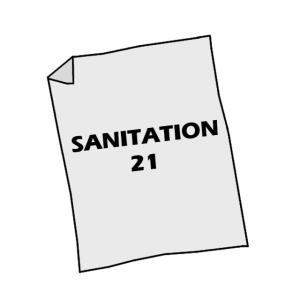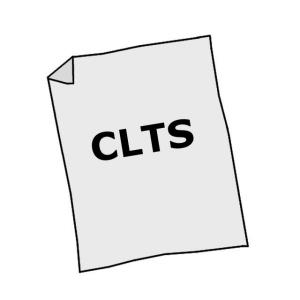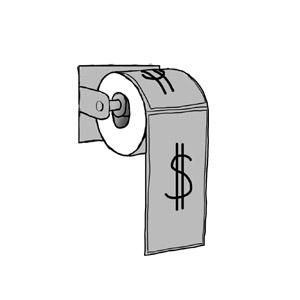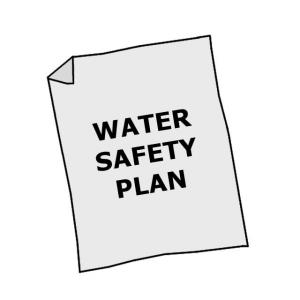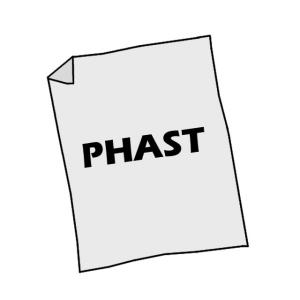Executive Summary
To reduce dependence on freshwater and maintain a constant source of water for irrigation throughout the year, wastewater of varying quality can be used in agriculture. However, only water that has had secondary treatment (i.e., physical and biological treatment) should be used to limit the risk of crop contamination and health risks to workers.
| In | Out |
|---|---|
Urine or Yellowwater, Fertigation Water, Treated Water |
Food Products |
Introduction
There are two kinds of irrigation technologies appropriate for treated wastewater:
- Drip irrigation above or below ground, where the water is slowly dripped on or near the root area; and
- Surface water irrigation where water is routed overland in a series of dug channels or furrows.
To minimize evaporation and contact with pathogens, spray irrigation should be avoided.
Properly treated wastewater can significantly reduce dependence on fresh water, and/or improve crop yields by supplying increased water and nutrients to plants. Raw sewage or untreated blackwater should not be used, and even well-treated water should be used with caution. Long-term use of poorly or improperly treated water may cause long-term damage to the soil structure and its ability to hold water.
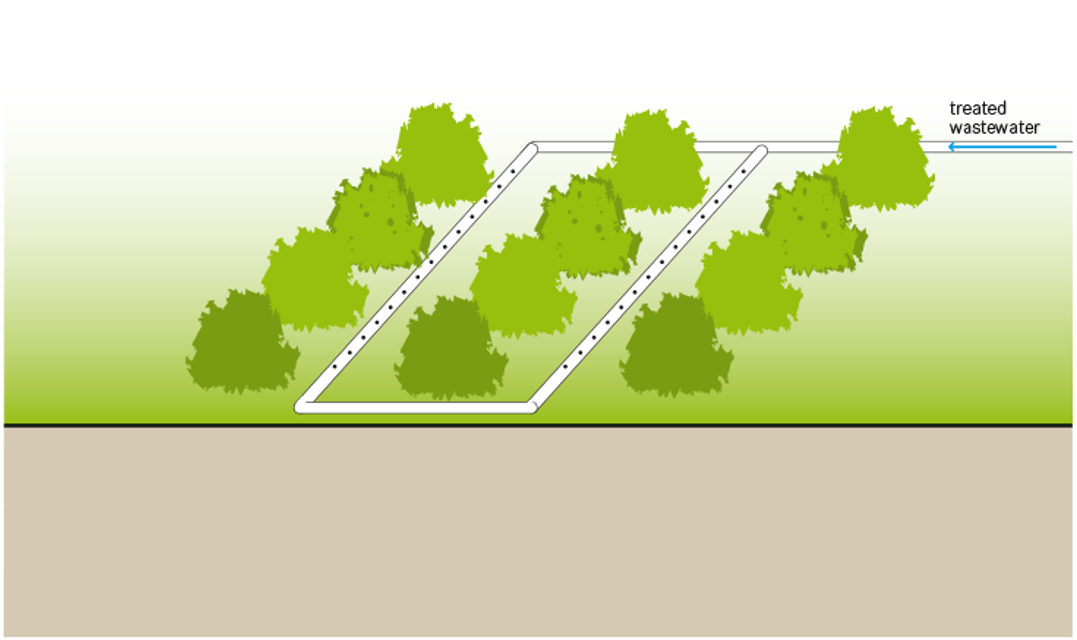
Design Considerations
The application rate must be appropriate for the soil, crop and climate, or it could be damaging. To increase the nutrient value, urine can be dosed into irrigation water; this is called “fertigation” (i.e., fertilization + irrigation). The dilution ratio has to be adapted to the special needs and resistance of the crop.
In drip irrigation systems care should be taken to ensure that there is sufficient head (i.e., pressure) and maintenance to reduce the potential for clogging (especially, with urine from which struvite will spontaneously precipitate).
Health Aspects/Acceptance
Appropriate treatment (i.e., adequate pathogen reduction) should precede any irrigation scheme to limit health risks to those who come in contact with the water. Furthermore, it may still be contaminated with the different chemicals that are discharged into the system depending on the degree of treatment the effluent has undergone. When effluent is used for irrigation, households and industries connected to the system should be made aware of the products that are and are not appropriate to discharge into the system. Drip irrigation is the only type of irrigation that should be used with edible crops, and even then, care should be taken to prevent workers and harvested crops from coming in contact with the treated effluent. The WHO Guidelines for the safe use of wastewater excreta and greywater Volume II should be consulted for detailed information and specific guidance.
Operation & Maintenance
Drip irrigation systems must be periodically flushed to avoid biofilm growth and clogging from all types of solids. Pipes should be checked for leaks as they are prone to damage from rodents and humans. Drip irrigation is more costly than conventional irrigation, but offers improved yields and decreased water/operating costs.
Workers should wear appropriate protective clothing.
Generally, drip irrigation is the most appropriate irrigation method; it is especially good for arid and drought prone areas. Surface irrigation is prone to large losses from evaporation but requires little or no infrastructure and may be appropriate in some situations.
Crops such as corn, alfalfa (and other feed), fibres (e.g., cotton), trees, tobacco, fruit trees (e.g., mangoes) and foods requiring processing (e.g., sugar beets) can be grown safely with treated effluent. More care should be taken with fruits and vegetables that may be eaten raw (e.g., tomatoes) because they could come in contact with the water. Energy crops like eucalyptus, poplar, willow, or ash trees can be grown in short-rotation and harvested for biofuel production. Since the trees are not for consumption, this is a safe, efficient way of using lower-quality effluent.
Soil quality can degrade over time (e.g., due to the accumulation of salts) if poorly treated wastewater is applied.Despite safety concerns, irrigation with effluent is an effective way to recycle nutrients and water.
Wastewater Irrigation and Health
This book is written for practitioners, researchers and graduate students in environmental and public health, sanitary and agricultural engineering, and wastewater irrigation management in developing countries. In particular, it should be useful for all those working to assess and mitigate health risks from the use of wastewater and faecal sludge in agriculture, under conditions where wastewater treatment is absent or inadequate to safeguard public health. In this respect, the book builds on and complements the international Guidelines for the Safe Use of Wastewater, Excreta and Greywater published in 2006 by the World Health Organization in collaboration with the Food and Agriculture Organization of the United Nations and the United Nations Environment Programme.
DRECHSEL, P. ; SCOTT, C.A. ; RASCHID-SALLY, L. ; REDWOOD, M. ; BAHRI, A. (2010): Wastewater Irrigation and Health. Assessing and Mitigating Risk in Low-Income Countries. London: Earthscan URL [Accessed: 07.05.2019]On-Farm Practices for the Safe Use of Wastewater in Urban and Peri-Urban Horticulture
This training handbook is a field guide for training urban and peri-urban vegetable farmers in safe practices when using wastewater in vegetable production. It is designed to provide complete information, knowledge and skills for safer and successful production of vegetables in urban and peri-urban farming systems.
FAO (2012): On-Farm Practices for the Safe Use of Wastewater in Urban and Peri-Urban Horticulture. A Training Handbook for Farmer Field Schools. Rome: Food and Agriculture Organization (FAO) URL [Accessed: 15.04.2014]More Crop Per Drop
Simple low-cost drip irrigation is practical and affordable for smallholder farmers. It has been successfully used in India and is becoming more popular in other southeast Asia and sub-Saharan Africa. It can reduce both water and labor use by as much as 20-50%. Yield of vegetables also can be increased by at least 10%. Our farm trials in Cambodia showed yield increases of 20-50% compared to traditional hand watering. Low pressure irrigation is also a key component of the African Market Garden concept jointly developed in west Africa with ICRISAT. This 10-chapter drip irrigation manual provides basic, step-by-step procedures for installing simple drip irrigation systems for different crops, climates, and soils.
PALADA, M. BHATTARAI, S. WU, D. ROBERTS, M. BHATTARAI, M. KIMSAN, R. MIDMORE, D. (2011): More Crop Per Drop. Using Simple Drip Irrigation Systems for Small-scale Vegetable Production. Shanhua, Tainan: AVRDC - The World Vegetable Center URL [Accessed: 08.05.2019]Wastewater Treatment and Use in Agriculture
This Irrigation and Drainage Paper is intended to provide guidance to national planners and decision-makers, agricultural and municipal managers, field engineers and scientists, health and agricultural field workers, wastewater treatment plant operators and farmers. Consequently, it covers a broad range of relevant material, some in considerable depth but some more superficially. It is meant to encourage the collection, treatment and use of wastewater in agriculture in a safe manner, with maximum advantage taken of this resource. Informal, unplanned and unorganized wastewater use is not recommended, nor is it considered adviseable from the health or agricultural points of view.
PESCOD, M.B. (1992): Wastewater Treatment and Use in Agriculture. (= FAO Irrigation and Drainage Paper , 47 ). Rome: Food and Agriculture Organisation of the United Nations (FAO) URL [Accessed: 25.10.2011]Guidelines for the safe use of wastewater excreta and greywater. Volume IV. Excreta and Greywater Use in Agriculture
Volume IV of the Guidelines for the Safe Use of Wastewater, Excreta and Greywater recognizes the reuse potential of wastewater and excreta (including urine) in agriculture and describes the present state of knowledge as regards potential health risks associated with the reuse as well as measures to manage these health risks following a multi-barrier approach.
WHO (2006): Guidelines for the safe use of wastewater excreta and greywater. Volume IV. Excreta and Greywater Use in Agriculture. Geneva: World Health Organisation (WHO) URL [Accessed: 09.05.2019] PDFThe Wealth of Waste
This report presents an economic framework for the assessment of the use of reclaimed water in agriculture, as part of a comprehensive planning process in water resource allocation strategies to provide for a more economically efficient and sustainable water utilization.
WINPENNY, J. HEINZ, I. KOO-OSHIMA, S. SALGOT, M. COLLADO, J. HERNANDEZ, F. TORRICELLI, R. (2010): The Wealth of Waste. The Economics of Wastewater Use in Agriculture. (= FAO Water Reports , 35 ). Rome: Food and Agriculture Organization (FAO) URL [Accessed: 15.04.2014]
